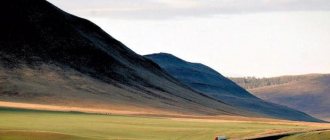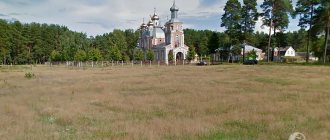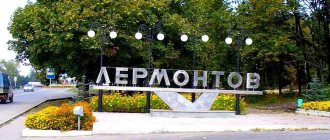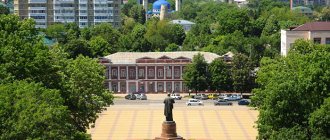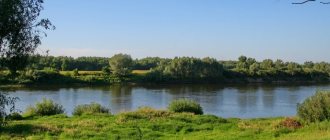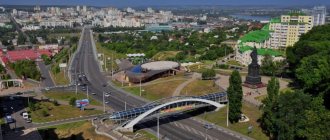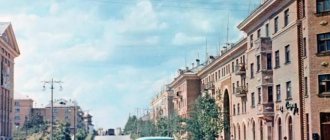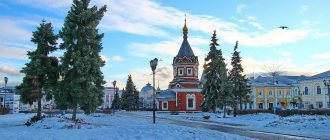| Langepas Khanty City: Langipos Flag | Coat of arms |
| A country | Russia, Russia |
| Subject of the federation | Khanty-Mansiysk Autonomous Okrug - YugraKhanty-Mansiysk Autonomous Okrug - Yugra |
| Urban district | Langepas city |
| Coordinates | 61°15′00″ n. w. 75°10′00″ E. d. / 61.25000° n. w. 75.16667° E. d. / 61.25000; 75.16667 (G) [www.openstreetmap.org/?mlat=61.25000&mlon=75.16667&zoom=12 (O)] (Z)Coordinates: 61°15′00″ N. w. 75°10′00″ E. d. / 61.25000° n. w. 75.16667° E. d. / 61.25000; 75.16667 (G) [www.openstreetmap.org/?mlat=61.25000&mlon=75.16667&zoom=12 (O)] (I) |
| Internal division | 9 microdistricts[1] |
| Mayor | Ukhabotov Andrey Ivanovich |
| Based | in 1980 |
| First mention | 1969 |
| Former names | Langepas |
| City with | August 15, 1985 |
| Square | 59.51 km² |
| Climate type | sharply continental |
| Population | ↗43,377[2] people (2016) |
| Density | 728.9 people/km² |
| National composition | Russians, Ukrainians, Belarusians, etc. |
| Names of residents | Langepastsy, Langepasets, Langepaska |
| Timezone | UTC+5 |
| Telephone code | +7 34669 |
| Postcode | 628672 |
| Vehicle code | 86 |
| OKATO code | [classif.spb.ru/classificators/view/okt.php?st=A&kr=1&kod=71132000 71 132 000] |
| Official site | [www.admlangepas.ru langepas.ru] |
| Langepas Moscow |
| : Incorrect or missing image Khanty-Mansiysk Langepas |
K: Settlements founded in 1980
Langepas
- a city (since 1985) in the Khanty-Mansiysk Autonomous Okrug, is a city of district subordination. The urban district is formed by the city of Langepas. Located in Western Siberia, on the right bank of the Kayukovskaya channel (Langepas) 15 kilometers from the Ob River. Population - 43,377[2] people. (2016).
The name of the city translated from the Khanty language means “Squirrel Land”.
Founded in 1980 in connection with the construction of the Lokosovsky gas processing plant and the Langepas village for oil workers and service personnel.
Geography
The city is located in the north of Western Siberia, in the middle reaches and on the right bank of the Ob River, 430 kilometers east of Khanty-Mansiysk, 930 kilometers northeast of Tyumen. In terms of climatic conditions, the region is equal to the Far North: winter lasts about seven months a year.
Timezone
| Langepas, like the entire Tyumen region, is located in the Ekaterinburg time zone. The offset relative to UTC is +5:00. Relative to Moscow time, the time zone has a constant offset of +2 hours and is designated in Russia as MSK+2. |
Climate
The city of Langepas and the urban district are equated to the regions of the Far North.
The climate of the city is sharply continental. Winters are cold, summers are moderately warm. The absolute minimum temperature was recorded at −59 °C.
- Average annual air temperature - −1.7 °C
- Relative air humidity - 75.4%
- Average wind speed - 3.1 m/s
| Langepas Climate | |||||||||||||
| Index | Jan. | Feb. | March | Apr. | May | June | July | Aug. | Sep. | Oct. | Nov. | Dec. | Year |
| Average temperature, °C | −21,7 | −18,1 | −9,8 | −4,3 | 5,2 | 13,8 | 17,8 | 14,0 | 6,5 | −1,3 | −17,2 | −21,8 | −1,7 |
| Source: [www.retscreen.net/ru/home.php NASA. RETScreen Database] | |||||||||||||
Flora and fauna
The city is surrounded by mixed taiga, rich in flora and fauna. The indigenous peoples of the North have long used them in their fishing. There are bear dens almost next to the city. There are many fur-bearing animals in the forests: muskrat, fox, chipmunk, hare, as well as the main symbol of Langepas - the squirrel. There are ducks and vipers in the swamps. Along with fur farming, fishing is also developed. The most common species are roach, ide, perch, crucian carp, pike, and muksun. You can also see white swans in some reservoirs near Lokosovo.
City
The city of Langepas is located in the central part of the West Siberian Plain between two large cities of the Khanty-Mansiysk Autonomous Okrug - Ugra: Nizhnevartovsk and Surgut. In 1985, by decision of the Tyumen Regional Council of People's Deputies, Langepas was given the status of a city of district subordination. It entered the galaxy of Lukoil cities. This is an original, comfortable city with a population of more than 43 thousand people. The difference between Langepas and other small northern cities is that it was built as a European-style city - with wide streets and squares. According to the master plan for the development of Langepas, the industrial and residential zones of the city are located taking into account future growth and the preservation of natural and environmental features. Today the city consists of 9 microdistricts, forming 2 large residential areas, between which the city public center is located. The long-term development plan provides for the construction of two new microdistricts in the near future.
Langepas Attractions
Despite its youth, the city of Langepas has its own monuments and attractions. The main one is the Square in memory of WWII soldiers with a memorial complex. Gray-haired veterans and first-graders come here on mournful days for our country to honor the memory of those who, at the cost of their lives, defended our right to life and freedom. On the brightest days of their lives, people come here to lay flowers and thank all those who died for saving their lives.
In 2001, the president of the oil company Lukoil presented the city with a monument, which was installed in the central square. It is made in the shape of a lotus flower and symbolizes the bright future of this city.
In 2005, “Squirrel” appeared on the city square of Langepas - a symbol of the city, made of bronze. The nose and ears of the sculpture simply sparkle in the sun, because residents believe that whoever rubs the squirrel will be happy.
The famous sculptor A. Kovalchuk works a lot and fruitfully for the city, whose works can be seen in the Tretyakov Gallery. “Memory of the Pioneers”, “After the Watch”, “Boy Playing with a Dog” - these are some of the author’s works exhibited in Langepas.
Education
There are 20 municipal educational institutions in the city: 10 preschool educational institutions, 6 general education institutions, 5 additional education institutions, 4 branches of higher educational institutions, an oil technical school, and a vocational college.
The city operates:
- School of Music
- Art school
- Center for additional education "Rainbow"
- Center for working with children and youth "Fortuna"
- Center for additional education "Patriot"
- Water sports complex "Dolphin"
- Sports complex "Langepas"
- Football stadium
- Indoor hockey court
- Indoor futsal stadium
- Indoor tennis court
- Sports complex "Vityaz"
- Sports and recreation complex (FOC)
- Museum and exhibition complex
Orthodox church
Built in 2001. On September 7, 2001, the temple was consecrated by Archbishop Dmitry of Tyumen and Tobolsk. There are about 200 permanent parishioners in the city. 60 people are Sunday school students. In February 2002, a sisterhood named after St. Xenia of St. Petersburg was created at the parish. Since 2007, the rector of the church parish has been Priest Valery Basakin. Traditional faiths, such as Islam and Orthodoxy, make a great contribution to the preservation of the traditions of their religions, to the education of the younger generation, and take an active part in the fight against drugs and their trafficking, tobacco smoking and alcoholism.
Mass media
Radio stations
- 67.28 MHz - Radio Russia / RGTRK "Yugoria"
- 100.4 MHz - Russian Radio / Russian Radio in Langepas
- 101.0 MHz – Radio Yugra
- 103.6 MHz - Europe Plus / Alliance
- 107.2 MHz—DFM
- 107.6 MHz – Road Radio / Radio Western Siberia
A television
- 10 TVK - Russia 1 / RGTRK "Yugoria"
- 12 TVK - Russia 2
- 26 TVK - Yugra
- 31 TVK - Channel One
- 33 TVK - Russia K
- 41 TVK - PLAN The second multiplex of digital television in Russia
- 44 TVK - The first multiplex of digital television in Russia
- 46 TVK - REN-TV / Langepas+
Press
City socio-political newspaper "Langepas Star". There are newspapers at schools and child support centers. Until January 1, 2011, the popular corporate newspaper of the Langepasneftegaz Chamber of Commerce and Industry, “Neftyanik Langepasa,” was published in the city. Recently, the city launched the Langepas Today information portal, which quickly reports important news.
Internet
- The Danzer company is a cable television (analog, digital, IP) and Internet operator. Has its own information channel;
- Rostelecom - television, Internet, home and mobile telephony
Notes
- [admlangepas.ru/engine/map-city/index.php City map on the official website of the Langepas city administration]
- ↑ 123
www.gks.ru/free_doc/doc_2016/bul_dr/mun_obr2016.rar Population of the Russian Federation by municipalities as of January 1, 2021 - [demoscope.ru/weekly/ssp/rus89_reg2.php All-Union Population Census of 1989. Urban population]. [www.webcitation.org/617x0o0Pa Archived from the original on August 22, 2011].
- ↑ 12345678910
www.MojGorod.ru/hmao/langepas/index.html People's encyclopedia “My City”. Langepas - [www.perepis2002.ru/ct/doc/1_TOM_01_04.xls All-Russian Population Census 2002. Volume. 1, table 4. Population of Russia, federal districts, constituent entities of the Russian Federation, districts, urban settlements, rural settlements - regional centers and rural settlements with a population of 3 thousand or more]. [www.webcitation.org/65AdCU0q3 Archived from the original on February 3, 2012].
- [www.gks.ru/bgd/regl/B09_109/IssWWW.exe/Stg/d01/tabl-21-09.xls Number of permanent population of the Russian Federation by cities, urban-type settlements and districts as of January 1, 2009]. Retrieved January 2, 2014. [www.webcitation.org/6MJmu0z1u Archived from the original on January 2, 2014].
- [tumstat.gks.ru/wps/wcm/connect/rosstat_ts/tumstat/resources/22904e804154168ab3dff7367ccd0f13/part+1.rar All-Russian population census 2010. Population size and its distribution in the Tyumen region]. Retrieved May 10, 2014. [www.webcitation.org/6PTJWMhJj Archived from the original on May 10, 2014].
- www.gks.ru/dbscripts/munst/munst71/DBInet.cgi?pl=8112027 Tyumen region. Estimated resident population as of January 1, 2009-2016
- [www.gks.ru/free_doc/doc_2012/bul_dr/mun_obr2012.rar Population of the Russian Federation by municipalities. Table 35. Estimated resident population as of January 1, 2012]. Retrieved May 31, 2014. [www.webcitation.org/6PyOWbdMc Archived from the original on May 31, 2014].
- [www.gks.ru/free_doc/doc_2013/bul_dr/mun_obr2013.rar Population of the Russian Federation by municipalities as of January 1, 2013. - M.: Federal State Statistics Service Rosstat, 2013. - 528 p. (Table 33. Population of urban districts, municipal districts, urban and rural settlements, urban settlements, rural settlements)]. Retrieved November 16, 2013. [www.webcitation.org/6LAdCWSxH Archived from the original on November 16, 2013].
- [www.gks.ru/free_doc/doc_2014/bul_dr/mun_obr2014.rar Table 33. Population of the Russian Federation by municipalities as of January 1, 2014]. Retrieved August 2, 2014. [www.webcitation.org/6RWqP50QK Archived from the original on August 2, 2014].
- [www.gks.ru/free_doc/doc_2015/bul_dr/mun_obr2015.rar Population of the Russian Federation by municipalities as of January 1, 2015]. Retrieved August 6, 2015. [www.webcitation.org/6aaNzOlFO Archived from the original on August 6, 2015].
- taking into account the cities of Crimea
- [www.gks.ru/free_doc/doc_2016/bul_dr/mun_obr2016.rar Population of the Russian Federation by municipalities as of January 1, 2021. Table “31. Population of cities and towns by federal districts and constituent entities of the Russian Federation as of January 1, 2021.” RAR archive (1.0 MB)]
- [demoscope.ru/weekly/knigi/zakon/zakon045.html Decree of the Government of the Russian Federation of January 1, 1993 No. 22 “On the list of areas inhabited by indigenous peoples of the North”]
Museum and Exhibition Center
It is interesting to know that the history of this still very young museum began with the collection of an amateur ethnographer, who for many years collected tools, clothing, and household items of the local population. Currently, more than 200 rare exhibits are kept in the museum’s collections. Quite recently, a “Young Ethnographer” circle was opened here.
Today you found out where the city of Langepas is located, how it lives, what plans its residents have for the future. In August 2014, Langepas turned 29 years old. For history, this is an infancy, but all the townspeople are confident that the city has a great and bright future ahead.
Excerpt characterizing Langepas
– Due to current circumstances, Sofya Danilovna and her children left for the Torzhkov village, your Excellency. “I’ll still come in, I need to sort out the books,” said Pierre. - Please, you are welcome, brother of the deceased, - the kingdom of heaven! “Makar Alekseevich remained, yes, as you know, they are weak,” said the old servant. Makar Alekseevich was, as Pierre knew, the half-crazy, hard-drinking brother of Joseph Alekseevich. - Yes, yes, I know. Let’s go, let’s go...” said Pierre and entered the house. A tall, bald old man in a dressing gown, with a red nose, and galoshes on his bare feet, stood in the hallway; Seeing Pierre, he muttered something angrily and went into the corridor. “They were of great intelligence, but now, as you can see, they have weakened,” said Gerasim. - Would you like to go to the office? – Pierre nodded his head. – The office was sealed and remains so. Sofya Danilovna ordered that if they come from you, then release the books. Pierre entered the same gloomy office that he had entered with such trepidation during the life of his benefactor. This office, now dusty and untouched since the death of Joseph Alekseevich, was even gloomier. Gerasim opened one shutter and tiptoed out of the room. Pierre walked around the office, went to the cabinet in which the manuscripts lay, and took out one of the once most important shrines of the order. These were genuine Scottish deeds with notes and explanations from the benefactor. He sat down at a dusty desk and put the manuscripts in front of him, opened them, closed them, and finally, moving them away from him, leaning his head on his hands, began to think. Several times Gerasim carefully looked into the office and saw that Pierre was sitting in the same position. More than two hours passed. Gerasim allowed himself to make noise in the doorway in order to attract Pierre's attention. Pierre didn't hear him. -Will you order the driver to be released? “Oh, yes,” Pierre said, waking up, hastily getting up. “Listen,” he said, taking Gerasim by the button of his coat and looking down at the old man with shiny, wet, enthusiastic eyes. “Listen, do you know that there will be a battle tomorrow?..” “They said,” answered Gerasim. “I ask you not to tell anyone who I am.” And do what I say... “I obey,” said Gerasim. - Would you like to eat? - No, but I need something else. “I need a peasant dress and a pistol,” said Pierre, suddenly blushing. “I’m listening,” Gerasim said after thinking. Pierre spent the entire rest of that day alone in his benefactor's office, restlessly walking from one corner to another, as Gerasim heard, and talking to himself, and spent the night on the bed that was prepared for him right there. Gerasim, with the habit of a servant who had seen many strange things in his lifetime, accepted Pierre's relocation without surprise and seemed pleased that he had someone to serve. That same evening, without even asking himself why it was needed, he got Pierre a caftan and a hat and promised to buy the required pistol the next day. That evening Makar Alekseevich, slapping his galoshes, approached the door twice and stopped, looking ingratiatingly at Pierre. But as soon as Pierre turned to him, he bashfully and angrily wrapped his robe around him and hastily walked away. While Pierre, in a coachman's caftan, purchased and steamed for him by Gerasim, went with him to buy a pistol from the Sukharev Tower, he met the Rostovs. On the night of September 1, Kutuzov ordered the retreat of Russian troops through Moscow to the Ryazan road. The first troops moved into the night. The troops marching at night were in no hurry and moved slowly and sedately; but at dawn the moving troops, approaching the Dorogomilovsky Bridge, saw ahead of them, on the other side, crowding, hurrying across the bridge and on the other side rising and clogging the streets and alleys, and behind them - pressing, endless masses of troops. And causeless haste and anxiety took possession of the troops. Everything rushed forward to the bridge, onto the bridge, into the fords and into the boats. Kutuzov ordered to be taken around the back streets to the other side of Moscow. By ten o'clock in the morning on September 2, only the rearguard troops remained in the open air in the Dorogomilovsky Suburb. The army was already on the other side of Moscow and beyond Moscow. At the same time, at ten o’clock in the morning on September 2, Napoleon stood between his troops on Poklonnaya Hill and looked at the spectacle that opened before him. Starting from the 26th of August and until the 2nd of September, from the Battle of Borodino until the enemy entered Moscow, all the days of this alarming, this memorable week there was that extraordinary autumn weather that always surprises people, when the low sun warms hotter than in the spring, when everything sparkles in the rare, clean air so that it hurts the eyes, when the chest becomes stronger and fresher, inhaling the fragrant autumn air, when the nights are even warm and when in these dark warm nights golden stars constantly rain down from the sky, frightening and delighting. On September 2 at ten o'clock in the morning the weather was like this. The shine of the morning was magical. Moscow from Poklonnaya Hill spread out spaciously with its river, its gardens and churches and seemed to live its own life, trembling like stars with its domes in the rays of the sun. At the sight of a strange city with unprecedented forms of extraordinary architecture, Napoleon experienced that somewhat envious and restless curiosity that people experience when they see the forms of an alien life that does not know about them. Obviously, this city lived with all the forces of its life. By those indefinable signs by which at a long distance a living body is unmistakably distinguished from a dead one. Napoleon from Poklonnaya Hill saw the flutter of life in the city and felt, as it were, the breath of this large and beautiful body. – Cette ville Asiatique aux innombrables eglises, Moscow la sainte. La voila donc enfin, cette fameuse ville! Il etait temps, [This Asian city with countless churches, Moscow, their holy Moscow! Here it is, finally, this famous city! It's time!] - said Napoleon and, dismounting from his horse, ordered the plan of this Moscou to be laid out in front of him and called the translator Lelorgne d'Ideville. “Une ville occupee par l'ennemi ressemble a une fille qui a perdu son honneur, [A city occupied by the enemy is like a girl who has lost her virginity.] - he thought (as he said this to Tuchkov in Smolensk). And from this point of view, he looked at the oriental beauty lying in front of him, whom he had never seen before. It was strange to him that his long-standing desire, which seemed impossible to him, had finally come true. In the clear morning light he looked first at the city, then at the plan, checking the details of this city, and the certainty of possession excited and terrified him. “But how could it be otherwise? - he thought. - Here it is, this capital, at my feet, awaiting its fate. Where is Alexander now and what does he think? Strange, beautiful, majestic city! And strange and majestic this minute! In what light do I appear to them? - he thought about his troops. “Here it is, the reward for all these people of little faith,” he thought, looking around at those close to him and at the troops approaching and forming. – One word of mine, one movement of my hand, and this ancient capital of des Czars perished. Mais ma clemence est toujours prompte a descendre sur les vaincus. [kings. But my mercy is always ready to descend to the vanquished.] I must be generous and truly great. But no, it’s not true that I’m in Moscow, it suddenly occurred to him. “However, here she lies at my feet, playing and trembling with golden domes and crosses in the rays of the sun. But I will spare her. On the ancient monuments of barbarism and despotism I will write great words of justice and mercy... Alexander will understand this most painfully, I know him. (It seemed to Napoleon that the main significance of what was happening lay in his personal struggle with Alexander.) From the heights of the Kremlin - yes, this is the Kremlin, yes - I will give them the laws of justice, I will show them the meaning of true civilization, I will force generations the boyars lovingly remember the name of their conqueror. I will tell the deputation that I did not and do not want war; that I waged war only against the false policy of their court, that I love and respect Alexander, and that I will accept peace terms in Moscow worthy of me and my peoples. I do not want to take advantage of the happiness of war to humiliate the respected sovereign. Boyars - I will tell them: I do not want war, but I want peace and prosperity for all my subjects. However, I know that their presence will inspire me, and I will tell them as I always say: clearly, solemnly and grandly. But is it really true that I am in Moscow? Yes, here she is! “Qu'on m'amene les boyards, [Bring the boyars.],” he addressed the retinue. The general with a brilliant retinue immediately galloped after the boyars. Two hours passed. Napoleon had breakfast and again stood in the same place on Poklonnaya Hill, awaiting the deputation. His speech to the boyars was already clearly formed in his imagination. This speech was filled with dignity and the greatness that Napoleon understood.
How our builders conquered Siberia, or the Belarusian city of Langepas
For many, the phrase “professionalism of Belarusian builders” has recently brought only an ironic smile. Meanwhile, solely thanks to the skill, endurance and ingenuity of domestic specialists, the city of Langepas with a population of many thousands has grown in the distant Siberian taiga. Stroyka.by found unique materials about how Belarusian builders conquered Siberia.
At the turn of the 70s and 80s of the last century, cities and towns began to grow one after another in the bed of the Ob River. For the Land of Soviets there was no more important task than the development of the huge oil and gas reserves discovered here. And each republic made its contribution.
The construction industry of the BSSR was given the task of building a city of oil workers, Langepas, thousands of kilometers from Minsk, on one of the sections of the endless Siberian taiga.
Arriving at the site, the participants of the first Belarusian landing saw only forests and swamps all around with a complete absence of roads. Langepas had to be built on permafrost with a harsh climate, where temperature differences range from +40 °C to –50 °C, and winter lasts 7(!) months.
Later, the builders recalled how the next morning the hair froze to the pillow. Or how, due to bad weather, there was no one to deliver food and fuel from the mainland, and they warmed up with a fire and lingonberry tea. At the same time, we worked a lot and hard...
Langepas, 1979. Start of construction
Of course, many believed then (and even now) that they were going to the North for a “long ruble.” But, you see, to work in such difficult conditions, money alone is not enough - there was an idea, a desire not to lose face, to complete everything accurately and on time, to defend the honor of the republic (it sounds pretentious, but it was so).
Yuri Puplikov, one of the first leaders of construction trust No. 37, which built Langepas, was appointed to this position from the post of head of Glavminskstroy (but there was no talk of any demotion - this is to understand the importance of the construction). He recalled: “It was important to “catch on” to this harsh land, very quickly create minimal conditions for people to live, develop a base for the main units of the trust, and form a combat-ready team. In a word, to prepare a springboard for the upcoming “big assault”, to carry out all the preparatory work, after which the construction of housing and other necessary urban facilities will be put on stream.”
The first building of construction trust No. 37
Many similar settlements in those years were built chaotically; there were not even minimal conditions - life in the North turned into many years of torture. Belarusians took a different path. From the very beginning, they insisted that it was necessary to build comprehensively, so that the city had infrastructure; living in barracks was a temporary measure. It is impossible even in 10 years to have amenities on the street and jump through the swamp in rubber boots.
Construction of the school, 1983
Another bold decision of the Belarusians was to build first for themselves, and then for the oil workers. It would seem like a utopia, since the slogan of those years was “Oil at any cost.” But domestic experts were still able to insist that a small “tactical hitch” would attract more builders to the site, and ultimately bring dividends. That's exactly what happened. The city was growing not just fast, but at a record pace.
In the memoirs of Yuri Puplikov we found another interesting episode from the life of the Belarusian conquerors of Siberia.
“For some reason (I don’t remember the details, and they’re not important now) the lights went out in the village. The fact that the light bulbs in the houses are not lit is not so bad. But the fact that a boiler room cannot operate without light is more serious. After all, winter is outside, which means there is a danger that the entire heating system of the village will defrost. The situation could indeed seem hopeless. And suddenly it dawned on me: what do our construction cranes work on? They're diesel-electric! This means that everyone’s engine is the most natural dynamo. I called electricians and crane operators. They started trying. Happened. They turned on the tap - and it worked for twelve hours, only “in reverse” - and all this time it fed the boiler room. So Langepas did not freeze that night. Neither before nor after have I heard of a crane being used in this particular capacity... But seriously, this is one example of the fact that there are no hopeless situations...
...One of the features of working in the North is the need to make decisions and bear responsibility for them. How could it be otherwise: all your superiors are thousands of kilometers away. You decide for yourself..."
It is no coincidence that people with a northern temperament, as a rule, were highly rated on the mainland for their ability to get out of the most difficult situations and take responsibility for their decisions.
The construction of buildings and structures in frozen soils, in swamps, in the harsh conditions of the North presented many mysteries and surprises in purely technological and engineering terms.
“Imagine, you are digging a pit to build a house, and its walls are crumbling. If you dig further, they continue to crumble. And so on almost ad infinitum. And then we applied our own, Belarusian method of solving this problem. It’s called a “wall in the ground”: a narrow, deep trench is dug along the perimeter of the pit in advance, filled with a special clay solution of a certain consistency - and you can safely tackle the pit itself, without fear that its edges will collapse. This technology had never been used by anyone in the north before us.”
Construction of a department store in Langepas, 1983
The appearance of Langepas was “programmed” in Belarus from the very beginning: first it appeared on the drawing boards of Minsk architects, and then it was built, mainly by the hands of our compatriots. Many Belarusians remained to live there, “overgrown” with children and grandchildren...
Now the country does not set such tasks for the industry. Therefore, it would be wrong to judge the professionalism of Belarusian builders only by a crooked wall in a new building.
If you don’t know the history of the city, it’s hard to imagine where the bus stop in Russian Langepas got its name.
In conclusion, a few more photos of modern Langepas. According to city guests, the cleanliness and well-grooming there are unusual for Russia. Otherwise! Judge for yourself. Personally, looking at these photos, we saw the trace of the blue-eyed one in Langepas.
When preparing the material, excerpts from L. Anikeev’s book “Belarusian Siberia” were used


